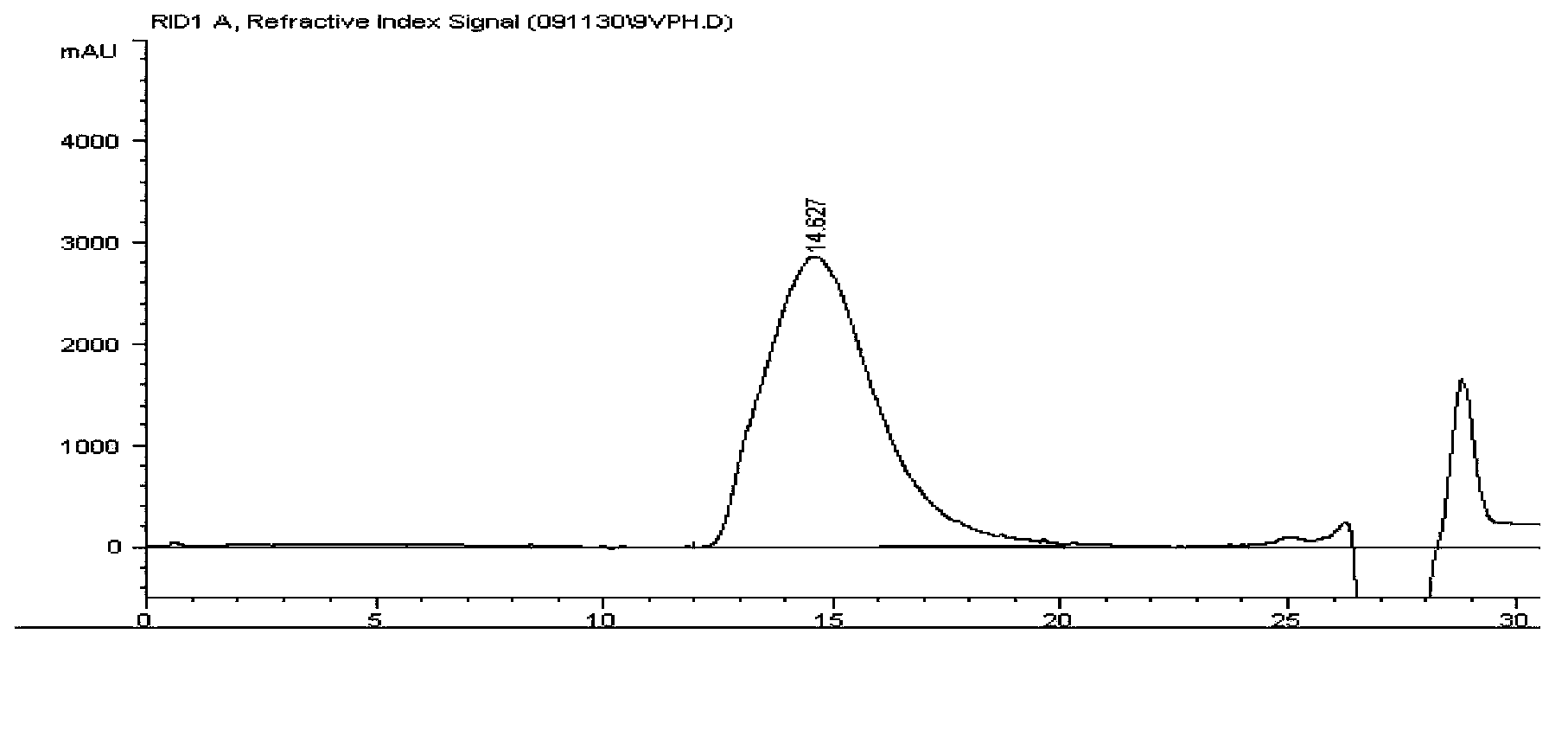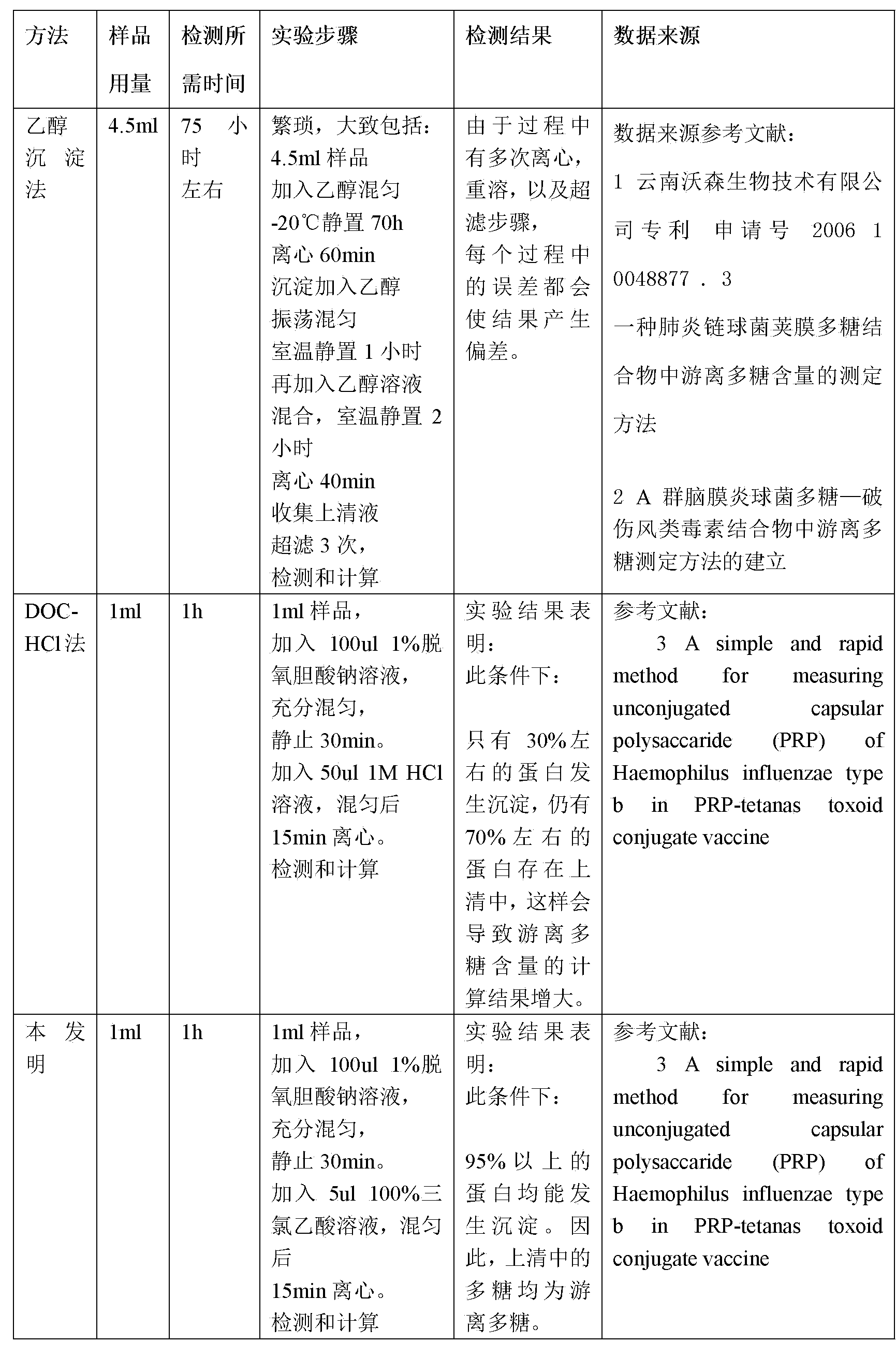Method for measuring free polysaccharide content in polysaccharide protein conjugate
A polysaccharide protein and determination method technology, applied in the field of vaccine detection, can solve the problems of deviation of free sugar content determination results, numerous steps, large sample volume, etc., and achieve the effects of saving sample amount, wide application range and simple determination.
- Summary
- Abstract
- Description
- Claims
- Application Information
AI Technical Summary
Problems solved by technology
Method used
Image
Examples
experiment example
[0035] Determination of free polysaccharide content in experimental example 9V-CRM197 conjugate
[0036] Take 1ml of 9V-CRM197, in which the concentration of 9V is 110ug / ml. Under the condition of ice-water bath, add 100ul of 1% sodium deoxycholate solution, mix thoroughly, and let stand for 30min. Then add 5ul of 100% trichloroacetic acid solution, mix well and centrifuge at 12000rpm at 4°C for 15min. Take the supernatant as the test sample A, take the conjugate stock solution to be tested as the test sample B, use the sulfate anthrone method to measure the polysaccharide content a and b in sample A and sample B respectively, and use the BCA method to measure the polysaccharide content a and b in A and B respectively. The protein content is c and d, according to the formula:
[0037] Free polysaccharide content=a / b *100% Calculate the free polysaccharide content in the stock solution of 9V-CRM197 conjugate as 4.5%.
[0038] The prerequisite for determining the content of f...
Embodiment 1
[0066] Take 1ml of 9V-CRM197, in which the concentration of 9V is 110ug / ml, add 100ul of 0.3% sodium deoxycholate solution in an ice-water bath, the addition amount is 5% of the volume of the original solution of the conjugate, mix well, and stand still for 20min; then add 5ul of 100% trichloroacetic acid solution, the amount added is 0.1% of the volume of the original solution of the conjugate, after mixing, centrifuge at 4°C, 8000rpm for 15;
[0067] Take the centrifuged supernatant as the test sample A, take the conjugate stock solution to be tested as the test sample B, use the sulfate anthrone method to measure the polysaccharide content in sample A and sample B respectively as a and b; use the BCA method to measure The protein content in A and B is c and d, according to the formula:
[0068] The free polysaccharide content in the polysaccharide-protein conjugate = a / b × 100% Calculate the free polysaccharide content in the stock solution of the 9V-CRM197 conjugate to be ...
Embodiment 2
[0071] Take 1ml of 9V-CRM197, in which the concentration of 9V is 110ug / ml, add 100ul of 3% sodium deoxycholate solution in an ice-water bath, the addition amount is 15% of the volume of the original solution of the conjugate, mix well, let stand for 40min; then add 100% trichloroacetic acid solution 5ul, the amount added is 1% of the volume of the conjugate stock solution, after mixing, centrifuge at 8°C, 12000rpm for 20min;
[0072] Take the centrifuged supernatant as the test sample A, take the conjugate stock solution to be tested as the test sample B, use the sulfate anthrone method to measure the polysaccharide content in sample A and sample B respectively as a and b; use the BCA method to measure The protein content in A and B is c and d, according to the formula:
[0073] Free polysaccharide content in the polysaccharide-protein conjugate = a / b × 100% Calculate the free polysaccharide content in the stock solution of the 9V-CRM197 conjugate to be 6.5%.
[0074] Protei...
PUM
 Login to View More
Login to View More Abstract
Description
Claims
Application Information
 Login to View More
Login to View More - R&D
- Intellectual Property
- Life Sciences
- Materials
- Tech Scout
- Unparalleled Data Quality
- Higher Quality Content
- 60% Fewer Hallucinations
Browse by: Latest US Patents, China's latest patents, Technical Efficacy Thesaurus, Application Domain, Technology Topic, Popular Technical Reports.
© 2025 PatSnap. All rights reserved.Legal|Privacy policy|Modern Slavery Act Transparency Statement|Sitemap|About US| Contact US: help@patsnap.com



